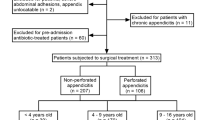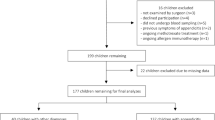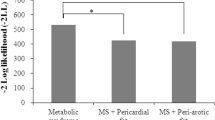Abstract
Objective
The aim of this study is to gain insights into the role of visceral adipose tissue as a source of C-reactive protein (CRP) in acute inflammation and to explore the potential relationship of CRP expression with the severity of appendicitis.
Methods
A total of 20 pediatric patients undergoing appendectomy were included in the study. Patients were divided into two groups according to appendicitis severity (uncomplicated and complicated). CRP levels were measured in visceral fat samples by western blotting, as well as in serum by biochemical testing.
Results
CRP was found to be expressed in visceral adipose tissue. The adipose tissue of patients with complicated appendicitis showed significantly higher CRP levels (p = 0.002) compared to patients with uncomplicated appendicitis. These results mirrored the CRP values obtained in serum (p = 0.018).
Conclusion
In childhood, visceral adipose tissue is a source of CRP in acute inflammation, and its expression is potentially associated with the severity of local inflammation.
Similar content being viewed by others
Introduction
C-reactive protein (CRP), which was discovered in 1930 in patients with pneumonia,1 was the first acute-phase protein to be described. The acute phase is a reaction of the organism to bacterial, viral, or parasitic infection, trauma, ischemic necrosis, or malignant growth.2 It is characterized by a non-specific systematic response of early onset (12–24 h), which causes an increase in the synthesis of acute-phase proteins.3 In this type of response, CRP levels can be increased up to 1000 times and have an approximate average half-life of 19 h.4
As a result of this increased presence, CRP has been widely used in the clinic as a marker of acute inflammation,2 though its characteristics also qualify it as a biomarker of the risk of acute appendicitis. There are studies on both children and adults that connect serum CRP levels with the severity of appendicitis, making the measurement of this protein a potential tool for the detection of complications.5,6
CRP is also considered as a marker of low-grade chronic inflammation in light of findings from studies carried out in recent years connecting CRP levels with body mass index.7,8,9 In addition, CRP has been employed as a cardiovascular risk marker.10,11,19 In the context of CRP as a marker of non-infectious inflammation, although adipose tissue has long been considered a mediator of hepatic CRP production due to the action of cytokines,7 recent studies have shown that adipose tissue may be an extrahepatic source of CRP in humans.8,9,12,13,14
To the best of our knowledge, no studies performed to date have investigated CRP expression in the adipose tissue of children or the potential link between CRP production and the severity of an inflammatory process. Thus, the aims of this study were to gain insights into the role of visceral adipose tissue as a source of CRP in acute inflammation, and to explore the potential relationship of CRP expression with appendicitis severity.
Subjects and methods
Sample size calculation
There are no similar studies in the literature that can be used to obtain reference values, thus making this a pilot study. Assuming a theoretical value of one arbitrary unit in the group of uncomplicated appendicitis and with the hope of obtaining a greater than 100% difference in CRP expression in adipose tissue among the group with complicated appendicitis, for a β-statistical power of 80% and a level of α significance of 5%, at least six patients in each group would be needed.
Study participants
Patients admitted to a pediatric hospital with a diagnosis of acute appendicitis and who underwent surgery were prospectively included in the study. The appendicitis diagnosis was established preoperatively by one of the consultant pediatric surgeons based on clinical history and physical examination. The patients were divided into two groups according to their anatomopathological findings.5,15 The first group (group 1) comprised patients with uncomplicated appendicitis (an intact appendiceal mucosa with mild-to-moderate infiltration of inflammatory cells), and the second group (group 2) included patients with complicated appendicitis (perforated or gangrenous appendicitis).
Complete clinical information was available for all enrolled patients, including data on the surgical intervention, anatomopathological findings, serum CRP levels, age, gender, weight, height, and Tanner stage. We calculated the body mass index of each patient as follows: [weight (kg)/height2 (m)]. Additionally, we estimated the Z-score for body mass index (BMI) according to age- and gender-matched Spanish reference data.16
Patients with incomplete clinical information were not included. Those patients with known chronic inflammatory pathology (i.e., gastrointestinal or rheumatic) were also ruled out from the study.
Human biological material
Serum samples were obtained from patients at the time of admission for surgery. Visceral fat samples were obtained from the greater omentum, through partial distal omentectomy using vascular ligation and sectioned directly with scissors without the use of an electric scalpel. Liver samples used as CRP-positive control were obtained following informed consent from adult patients undergoing bariatric surgery. All samples were cleaned and stored in a sterile container at –80 °C for further biomolecular assays.
Protein preparation for western blotting
For total protein extraction, the tissue samples (500 µg) were homogenized at 4 °C in 1.25% Triton X-100, containing 250 mM sucrose, 20 mM Tris/HCl, 2.5 mM MgCl2, 50 mM β-mercaptoethanol, 1.2 mM EGTA, 1 mM Na3VO4, 5 mM Na4P2O7, 50 mM NaF, 2 μM leupeptin, 2 μM pepstatin, pH 7.4, and 2 mM phenylmethylsulfonyl fluoride. The homogenized tissue samples were then maintained at 4 °C for 30 min and centrifuged at 15,000 × g to remove tissue debris. The supernatant (tissue lysate), containing cytosol and solubilized membrane proteins, was kept at –80 °C, and an aliquot of each extract was preserved for protein quantification by bicinchoninic acid assay (BCA, Thermo Fisher Scientific).17
Electrophoresis and western blot assay
Equal amounts (30 µg) of tissue lysates from each sample were subjected to SDS-PAGE,18,19 in parallel with molecular weight markers, on a 10% resolving gel. The resolved proteins were then transferred onto nitrocellulose membranes in a semidry system (Trans-Blot SD semi-dry transfer cell; Bio-Rad). For immunodetection, CRP antibody (1:1000) (Abcam, Y284) and β-actin antibody (1:2500) (Thermo Fisher Scientific, PA1-16889) were used as internal loading controls. Horseradish peroxidase-conjugated goat anti-rabbit immunoglobulin (1:2000) (Thermo Fisher Scientific, G21234) was employed as the secondary antibody. Proteins were visualized using the ECL kit (Thermo Fisher Scientific), with detection by the enhanced chemiluminescence method (GE Healthcare Bio-Sciences AB, ImageQuant LAS 4000), and analyzed with the image analysis program Quantity One (Bio-Rad Laboratories, Hercules, CA). Data are reported as the band intensity of immunostaining values (arbitrary units) obtained by normalization based on the densitometry value of the CRP relative to those obtained for β-actin. The value obtained from human liver tissue was used as a control.
Determination of serum CRP concentrations
Serum samples were quantified by an autoanalyzer using an immunoassay based on an enzymatic heterogeneous, sandwich immunoassay format (Ortho-Clinical Diagnostics). The limit of detection for the assay was 0.272 mg/dl and the limit of quantitation was 0.480 mg/dl. Levels below the limit of quantitation were set to 0.5 mg/dl before statistical analysis.
Statistical analysis
The SPSS 19.0 and GraphPad Prism statistical programs were used for statistical analysis. We used the Kolmogorov–Smirnov test to analyze the normality of the variables studied. Variables not normally distributed were log-transformed before analysis. The data were expressed as means ± SEM (standard error of mean) and analyzed by a parametric Student’s t-test. Categorical variables were compared using the chi-square test. Statistical significance was set at a p-value <0.05.
Ethical approval
Informed written consent was obtained from parents or legal guardians of all participants, but assent was also obtained from patients older than 12 years before being enrolled in the study. The study was approved by the Ethics Committee of the Instituto de Investigación Sanitaria-Fundación Jiménez Díaz, Madrid, Spain, in accordance with the Declaration of Helsinki.
Results
A total of 20 patients were studied, of whom 11 belonged to group 1 (uncomplicated AA) and nine to group 2 (complicated AA). There were no significant differences in gender, age, Z-score, BMI, or Tanner stage (Table 1).
CRP expression was confirmed in the visceral adipose tissue of these children, particularly in patients with complicated appendicitis. To analyze the relationship between CRP expression levels and the severity of appendicitis, the averages of the arbitrary CRP units of groups 1 and 2 were compared (uncomplicated appendicitis vs. complicated appendicitis), revealing a significant difference between the two groups (p = 0.002). The lowest expression levels were detected in group 1 (0.96 ± 0.68), while the highest values were seen in group 2 (4.11 ± 1.20) (Fig. 1).
a Comparison of CRP expression measured by western blot in the visceral fat of patients with uncomplicated appendicitis (group 1) and complicated appendicitis (group 2). b CRP expression was measured by western blot analysis. This image is representative of the experiments and showed one sample of liver tissue (CRP-positive control) and six samples of visceral adipose tissue from patients with appendicitis undergoing surgery. The first three samples belong to group 1 (uncomplicated appendicitis) and the next three to group 2 (complicated appendicitis). Actin protein levels were determined as an internal loading control. The results are expressed as means ± SEM. **p-values by Student’s t test: <0.01
Lower serum CRP levels were found in patients from group 1 (2.86 ± 0.89 mg/dl) compared to those from group 2 (10.33 ± 2.71 mg/dl), with this difference reaching statistical significance (p = 0.018) (Fig. 2). In the non-complicated appendicitis group, 5 out of the 11 patients presented serum CRP levels below 0.5 mg/dl, whereas in the complicated appendicitis group, only one patient out of nine presented levels lower than 0.5 mg/dl.
Discussion
The present study demonstrates CRP expression at the protein level in visceral adipose tissue of children with appendicitis. Previous studies have evidenced the expression of CRP in adipose tissue at both the protein and mRNA level;12,13,14,15,16 to our knowledge, our study is the first to show protein-level expression in samples from pediatric patients with appendicitis.
We have also found out that there was a significant difference between the expression of CRP in adipose tissue of patients with uncomplicated and complicated appendicitis, revealing fourfold higher values in those with complicated appendicitis. Thus, CRP expression in visceral adipocytes could be linked to the degree of local inflammation, which likely triggers the inflammatory response. Our findings support those of Peyrin-Biroulet et al.,9 as in their study on CRP in Crohn’s disease, the authors concluded that the inflammatory response is likely triggered due to the production of CRP resulting from local inflammation of adipocytes.
The fact that adipose tissue has a greater expression of CRP in cases of complicated than uncomplicated appendicitis is of great relevance, as it not only confirms that adipose tissue is an extrahepatic source of CRP, but also indicates that adipose tissue may actively participate in the inflammatory response by increasing the production of CRP. It should be noted that adipose tissue upregulates the expression of IL-6 and IL-6 receptors,12 which play a fundamental role in regulating CRP expression, thereby increasing the synthesis and secretion of CRP by adipocytes.12,13 Indeed, this study would have been enriched by an evaluation of CRP expression in adipose tissue in chronic low-grade inflammatory obesity, as recent studies have done.12
With regard to blood CRP levels, several studies, both in adults6,20,21,22 and in children,5,23,24 have shown that blood CRP levels are an accurate marker of appendicitis severity and therefore are a useful tool in the diagnosis of complicated appendicitis. Our results support these findings, as we observed a 3.6-fold increase in serum CRP levels at complicated appendicitis. In addition, 54.5% of patients with uncomplicated appendicitis had normal values of serum CRP (<0.5 mg/dl), which lends further support to the study of Grönroos et al.,25 which found that normal CRP levels were not indicative of an absence of appendicitis in children.
Having considered the results obtained in adipose tissue and serum, we can observe the same behavior in both the cases, but CRP increases according to the severity of inflammation. However, methodological limitations prevented us from assessing the possible correlation between CRP levels in adipose tissue and serum.
The main limitation of our study lies in our inability to obtain control samples of adipose tissue from healthy patients, as such samples could have been used to test CRP protein expression in healthy patients. Another limiting factor is the absence of quantitative measurement CRP levels secreted by adipose tissue. It is possible that a bigger sample size would be of interest; however, consistent results have been found. Lastly, an analysis of the CRP expression levels in subcutaneous adipose tissue would have enriched our study.
In conclusion, visceral adipose tissue in pediatric age is a source of CRP in acute inflammation and its expression is potentially associated with the severity of local inflammation in appendicitis. These results set up future lines of research that could elucidate the role of adipose tissue and CRP in chronic non-infectious inflammatory processes.
References
Tillett, W. S. & Francis, T. Serological reactions in pneumonia with a nonprotein somatic fraction of pneumococcus. J. Exp. Med. 52, 561–571 (1930).
Jain, S., Gautam, V. & Naseem, S. Acute-phase proteins: as diagnostic tool. J. Pharm. Bioallied Sci. 3, 118–127 (2011).
Black, S., Kushner, I. & Samols, D. C-reactive protein. J. Biol. Chem. 279, 48487–48490 (2004).
Pepys, M. B. & Hirschfield, G. M. C-reactive protein: a critical update. J. Clin. Invest. 111, 1805–1812 (2003).
Gavela, T., Cabeza, B., Serrano, A. & Casado-Flores, J. C-reactive protein and procalcitonin are predictors of the severity of acute appendicitis in children. Pediatr. Emerg. Care 28, 416–419 (2012).
Buyukbese Sarsu, S. & Sarac, F. Diagnostic value of white blood cell and C-reactive protein in pediatric appendicitis. Biomed. Res. Int. 2016, 6508619 (2016).
Therapy, E. A new perspective on the biology of C-reactive protein. Circ. Res. 3, 12–15 (2005).
Noorjamal, N. A. et al. C-reactive protein is highly expressed in visceral adipose tissue of obese but not lean subjects: a post mortem study. Atherosclerosis 263, e122 (2017).
Peyrin-Biroulet, L. et al. Mesenteric fat as a source of C reactive protein and as a target for bacterial translocation in Crohn’s disease. Gut 61, 78–85 (2012).
Greenfield, J. R. et al. Obesity is an important determinant of baseline serum C-reactive protein concentration in monozygotic twins, independent of genetic influences. Circulation 109, 3022–3028 (2004).
Choi, J., Joseph, L. & Pilote, L. Obesity and C-reactive protein in various populations: a systematic review and meta-analysis. Obes. Rev. 14, 232–244 (2013).
Memoli, B. et al. Inflammation may modulate IL-6 and C-reactive protein gene expression in the adipose tissue: the role of IL-6 cell membrane receptor. Am. J. Physiol. Endocrinol. Metab. 293, E1030–E1035 (2007).
Anty, R. et al. The inflammatory C-reactive protein is increased in both liver and adipose tissue in severely obese patients independently from metabolic syndrome, type 2 diabetes, and NASH. Am. J. Gastroenterol. 101, 1824–1833 (2006).
Ouchi, N. et al. Reciprocal association of C-reactive protein with adiponectin in blood stream and adipose tissue. Circulation 107, 671–674 (2003).
Vaughan-Shaw, P. G., Rees, J. R., Bell, E., Hamdan, M. & Platt, T. Normal inflammatory markers in appendicitis: evidence from two independent cohort studies. JRSM Short. Rep. 2, 43 (2011).
Carrascosa Lezcano, A. et al. [Spanish cross-sectional growth study 2008. Part II. Height, weight and body mass index values from birth to adulthood]. An Pediatr. 68, 552–569 (2008).
Smith, P. K. et al. Measurement of protein using bicinchoninic acid. Anal. Biochem. 150, 76–85 (1985).
Laemmli, U. K. Cleavage of structural proteins during the assembly of the head of bacteriophage T4. Nature 227, 680–685 (1970).
Oliveira, A. C. et al. Alanine aminotransferase and high sensitivity C-reactive protein: correlates of cardiovascular risk factors in youth. J. Pediatr. 152, 337–342 (2008).
Kaya, B. et al. The diagnostic value of D-dimer, procalcitonin and CRP in acute appendicitis. Int J. Med Sci. 9, 909–915 (2012).
Mcgowan, D. R., Sims, H. M., Zia, K., Uheba, M. & Shaikh, I. A. The value of biochemical markers in predicting a perforation in acute appendicitis. ANZ J Surg 83, (79–83 (2013).
Panagiotopoulou, I. G. et al. The diagnostic value of white cell count, C-reactive protein and bilirubin in acute appendicitis and its complications. Ann. R. Coll. Surg. Engl. 95, 215–221 (2013).
Chung, J. L. et al. Diagnostic value of C-reactive protein in children with perforated appendicitis. Eur. J. Pediatr. 155, 529–531 (1996).
Zani, A. et al. Can common serum biomarkers predict complicated appendicitis in children? Pediatr Surg Int 33, (799–805 (2017).
Grönroos, P., Huhtinen, H. & Grönroos, J. M. Normal leukocyte count and C-reactive protein value do not effectively exclude acute appendicitis in children. Dis. Colon Rectum 52, 1028–1029 (2009).
Acknowledgements
This work was supported by a grant from the Fondo de Investigación Sanitaria (FIS 14/00344) and Biobank grant FEDER RD09/0076/00101.
Author information
Authors and Affiliations
Corresponding author
Ethics declarations
Competing interests
Olaya de Dios is a fellow of the Conchita Rábago Foundation. The remaining authors declare that they have no competing interests.
Additional information
Publisher's note: Springer Nature remains neutral with regard to jurisdictional claims in published maps and institutional affiliations.
Rights and permissions
About this article
Cite this article
de Dios, O., Gavela-Pérez, T., Aguado-Roncero, P. et al. C-reactive protein expression in adipose tissue of children with acute appendicitis. Pediatr Res 84, 564–567 (2018). https://doi.org/10.1038/s41390-018-0091-z
Received:
Revised:
Accepted:
Published:
Issue Date:
DOI: https://doi.org/10.1038/s41390-018-0091-z





